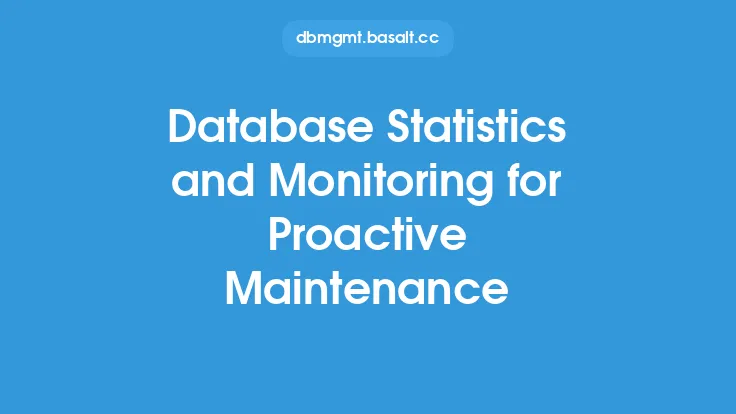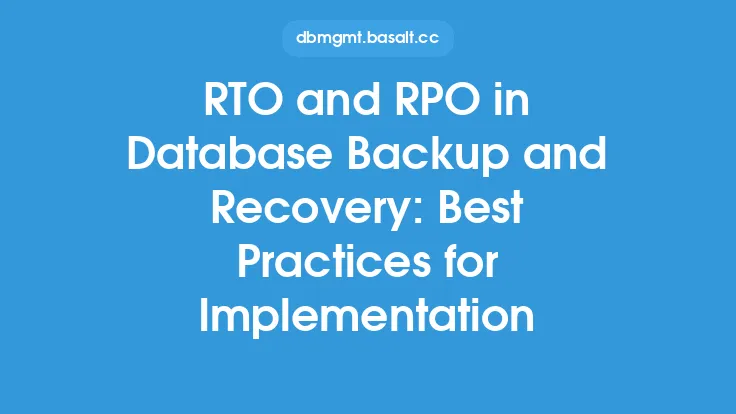When it comes to database performance optimization, collecting and analyzing database statistics is a crucial step in identifying areas for improvement and ensuring the overall health and efficiency of the database. Database statistics provide valuable insights into the database's behavior, allowing administrators to make informed decisions about indexing, caching, query optimization, and other performance-related tasks. In this article, we will delve into the best practices for database statistics collection and analysis, providing a comprehensive guide for database administrators and developers.
Introduction to Database Statistics
Database statistics refer to the collection of data that describes the database's structure, usage patterns, and performance characteristics. This data can include information about table and index sizes, data distribution, query execution plans, and system resource utilization. By analyzing database statistics, administrators can identify trends, patterns, and anomalies that may be impacting performance, and take corrective action to optimize the database.
Types of Database Statistics
There are several types of database statistics that can be collected, including:
- Table and index statistics: These statistics provide information about the size and structure of tables and indexes, including the number of rows, data distribution, and index cardinality.
- Query statistics: These statistics provide information about query execution plans, including the number of executions, execution time, and resource utilization.
- System statistics: These statistics provide information about system resource utilization, including CPU, memory, and disk usage.
- Wait statistics: These statistics provide information about the types of waits that are occurring in the database, including waits for CPU, memory, disk, and network resources.
Best Practices for Collecting Database Statistics
To get the most out of database statistics, it's essential to follow best practices for collecting and storing the data. Here are some guidelines to keep in mind:
- Collect statistics regularly: Database statistics should be collected on a regular basis, such as daily or weekly, to ensure that the data is up-to-date and reflects current usage patterns.
- Use automated tools: Automated tools, such as database management system (DBMS) built-in utilities or third-party software, can simplify the process of collecting and storing database statistics.
- Store statistics in a centralized repository: Storing database statistics in a centralized repository, such as a data warehouse or a dedicated statistics database, makes it easier to analyze and compare data across different databases and time periods.
- Ensure data consistency: Ensure that the data is consistent and accurate, by using standardized collection methods and verifying the data for errors or inconsistencies.
Analyzing Database Statistics
Once the database statistics have been collected, the next step is to analyze the data to identify trends, patterns, and anomalies. Here are some best practices for analyzing database statistics:
- Use visualization tools: Visualization tools, such as charts, graphs, and heat maps, can help to identify trends and patterns in the data, and make it easier to communicate findings to stakeholders.
- Look for correlations: Look for correlations between different types of statistics, such as between query execution plans and system resource utilization, to identify potential performance bottlenecks.
- Analyze data over time: Analyze data over time to identify seasonal or periodic trends, and to track the effectiveness of performance optimization efforts.
- Drill down into detailed data: Drill down into detailed data, such as individual query execution plans or system resource utilization metrics, to identify specific performance issues and opportunities for optimization.
Common Challenges and Pitfalls
When collecting and analyzing database statistics, there are several common challenges and pitfalls to be aware of, including:
- Data overload: Collecting too much data can lead to information overload, making it difficult to identify relevant trends and patterns.
- Data quality issues: Poor data quality, such as missing or inaccurate data, can lead to incorrect conclusions and ineffective optimization efforts.
- Lack of standardization: Lack of standardization in data collection and analysis methods can make it difficult to compare data across different databases and time periods.
- Insufficient resources: Insufficient resources, such as CPU, memory, or disk space, can limit the ability to collect and analyze database statistics.
Tools and Techniques for Database Statistics Collection and Analysis
There are several tools and techniques available for collecting and analyzing database statistics, including:
- DBMS built-in utilities: Most DBMSs provide built-in utilities for collecting and analyzing database statistics, such as Oracle's Enterprise Manager or Microsoft's SQL Server Management Studio.
- Third-party software: Third-party software, such as database monitoring and performance optimization tools, can provide additional features and functionality for collecting and analyzing database statistics.
- Custom scripts and programs: Custom scripts and programs can be used to collect and analyze database statistics, providing a high degree of flexibility and customization.
- Data visualization tools: Data visualization tools, such as Tableau or Power BI, can be used to create interactive and dynamic visualizations of database statistics, making it easier to identify trends and patterns.
Conclusion
Collecting and analyzing database statistics is a critical step in database performance optimization, providing valuable insights into the database's behavior and identifying opportunities for improvement. By following best practices for collecting and analyzing database statistics, and using the right tools and techniques, database administrators and developers can optimize database performance, improve efficiency, and reduce costs. Whether you're working with a small, medium, or large-scale database, database statistics collection and analysis is an essential part of ensuring the overall health and efficiency of the database.





